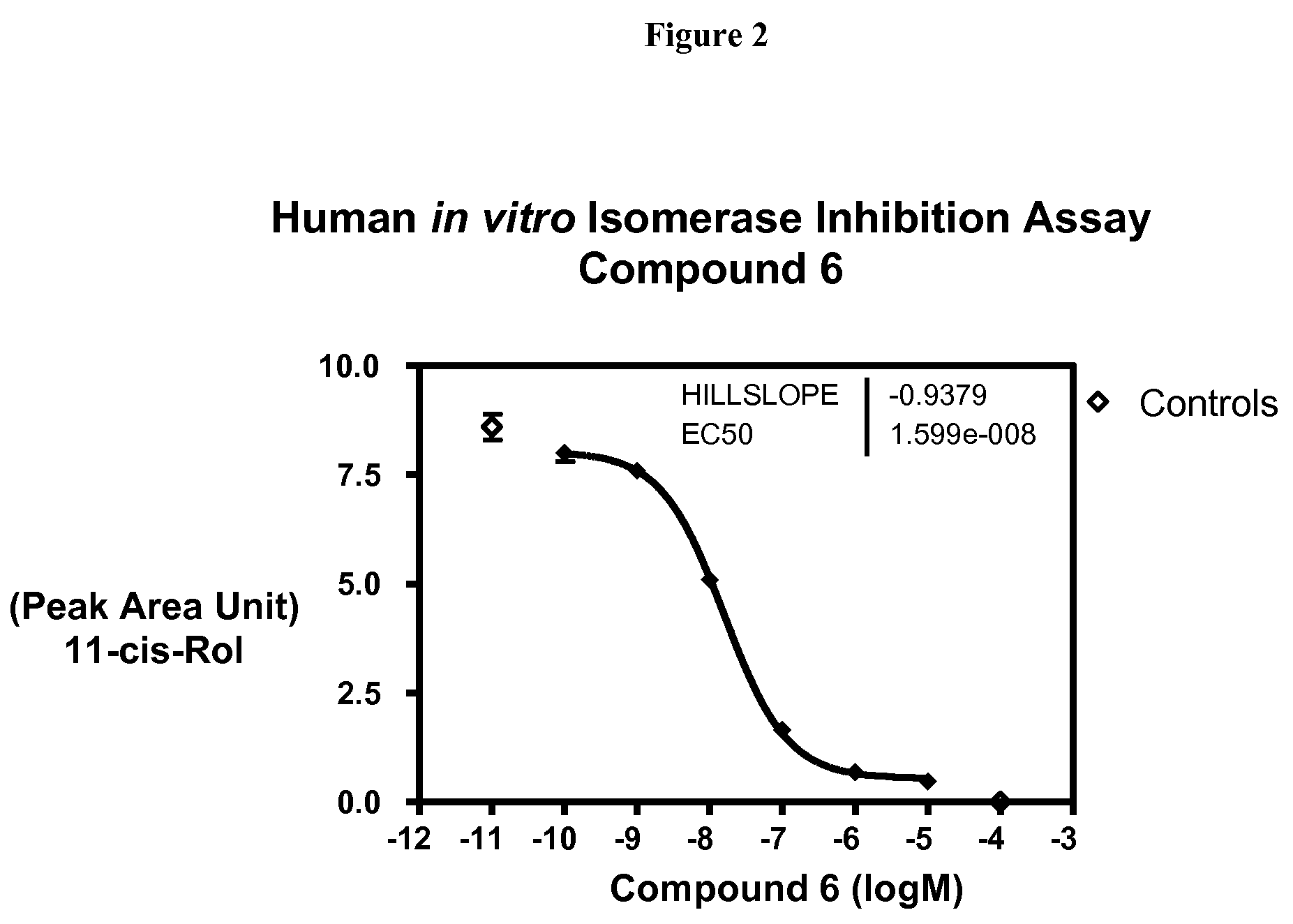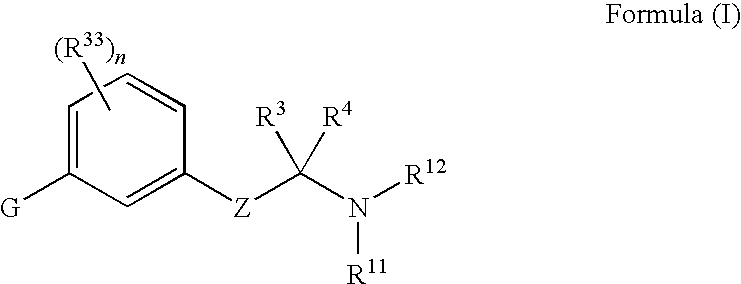Compounds for treating ophthalmic diseases and disorders
a technology for applied in the field of compound for treating ophthalmic diseases and disorders, can solve the problems of blindness in the central vision, damage to the overlying retina, and blindness in aging populations worldwide, and achieve the effect of reducing ischemia and reducing ischemia in the ey
- Summary
- Abstract
- Description
- Claims
- Application Information
AI Technical Summary
Benefits of technology
Problems solved by technology
Method used
Image
Examples
example 1
Preparation of N-(3-(2-aminoethoxy)phenyl)pentane-2-sulfonamide
[1212]
[1213]N-(3-(2-Aminoethoxy)phenyl)pentane-2-sulfonamide was prepared following the method shown in Scheme 1.
[1214]
[1215]Step 1: A mixture of 1-aminophenol (1) (207 mg, 1.9 mmol), 2-(tert-butoxycarbonylamino)ethyl 4-methylbenzenesulfonate (2) (500 mg, 1.9 mmol), and cesium carbonate (770 mg, 2.2 mmol) in DMF (6 ml) was stirred at room temperature under argon for 15 hours. The mixture was concentrated under reduced pressure. The residue was partitioned between EtOAc and water. The organic layer was washed with brine, dried over Na2SO4 and concentrated under reduced pressure. Purification by flash chromatography (40 to 60% EtOAc-hexanes gradient) gave tert-butyl 2-(3-aminophenoxy)ethylcarbamate (3) as colorless oil. Yield (220 mg, 58%). 1H NMR (400 MHz, DMSO-d6) δ 6.92 (t, J=5.2 Hz, 1H), 6.85 (t, J=8.0 Hz, 1H), 6.08-6.12 (m, 2H), 6.02-6.04 (m, 1H), 4.99 (bs, 2H), 3.79 (t, J=6.0 Hz, 2H), 3.21 (q, J=6.0 Hz, 2H), 1.36 (s,...
example 2
Preparation of N-(3-(2-aminoethoxy)phenyl)butane-2-sulfonamide
[1218]
[1219]N-(3-(2-Aminoethoxy)phenyl)butane-2-sulfonamide was prepared following the method described in Example 1.
[1220]Step 1: Sulfonation of tert-butyl 2-(3-aminophenoxy)ethylcarbamate (3) using butane-2-sulfonyl chloride following the method described in Example 1 gave tert-butyl 2-(3-(1-methylpropylsulfonamido)phenoxy)ethylcarbamate (6) as a light yellow oil. 1H NMR (400 MHz, DMSO-d6) δ 9.72 (s, 1H), 7.17 (t, J=8.0 Hz, 1H), 6.97 (t, J=6.0 Hz, 1H), 6.76-6.78 (m, 2H), 6.59-6.62 (m, 1H), 3.87 (t, J=5.6 Hz, 2H), 3.24 (q, J=6.4 Hz, 2H), 2.93-3.02 (m, 1H), 1.80-1.91 (m, 1H), 1.40-1.48 (m, 1H), 1.35 (s, 9H), 1.19 (d, J=6.8 Hz, 3H), 0.88 (t, J=7.2 Hz, 3H).
[1221]Step 2: Deprotection of tert-butyl 2-(3-(1-methylpropylsulfonamido)phenoxy)ethylcarbamate (6) following the method described in Example 1 gave Example 2 as a colorless oil. 1H NMR (400 MHz, DMSO-d6) δ 7.16 (t, J=8.0 Hz, 1H), 6.75-6.77 (m, 2H), 6.59-6.62 (m, 1H), 3.8...
example 3
Preparation of N-(3-(2-aminoethoxy)phenyl)propane-2-sulfonamide
[1222]
[1223]N-(3-(2-Aminoethoxy)phenyl)propane-2-sulfonamide was prepared following the method described in Example 1.
[1224]Step 1: Sulfonation of tert-butyl 2-(3-aminophenoxy)ethylcarbamate (3) using propane-2-sulfonyl chloride following the method described in Example 1 gave tert-butyl 2-(3-(1-methylethylsulfonamido)phenoxy)ethylcarbamate (7) as a light yellow oil. 1H NMR (400 MHz, DMSO-d6) δ 9.70 (s, 1H), 7.17 (t, J=8.0 Hz, 1H), 6.97 (t, J=6.0 Hz, 1H), 6.76-6.79 (m, 2H), 6.60-6.62 (m, 1H), 3.16-3.30 (m, 3H), 1.35 (s, 9H), 1.19 (d, J=6.8 Hz, 6H).
[1225]Step 2: Deprotection of tert-butyl 2-(3-(1-methylethylsulfonamido)phenoxy)ethylcarbamate (7) following the method described in Example 1 gave Example 3 as a white solid. 1H NMR (400 MHz, DMSO-d6) δ 9.80 (s, 1H), 8.07 (bs, 3H), 7.21 (t, J=8.0 Hz, 1H), 6.86 (t, J=2.0 Hz, 1H), 6.81 (dd, J=8.0, 2.0 Hz, 1H), 6.66 (dd, J=8.0, 2.0 Hz, 1H), 4.10 (t, J=5.2 Hz, 2H), 3.15-3.24 (m, 3...
PUM
 Login to View More
Login to View More Abstract
Description
Claims
Application Information
 Login to View More
Login to View More - R&D
- Intellectual Property
- Life Sciences
- Materials
- Tech Scout
- Unparalleled Data Quality
- Higher Quality Content
- 60% Fewer Hallucinations
Browse by: Latest US Patents, China's latest patents, Technical Efficacy Thesaurus, Application Domain, Technology Topic, Popular Technical Reports.
© 2025 PatSnap. All rights reserved.Legal|Privacy policy|Modern Slavery Act Transparency Statement|Sitemap|About US| Contact US: help@patsnap.com



